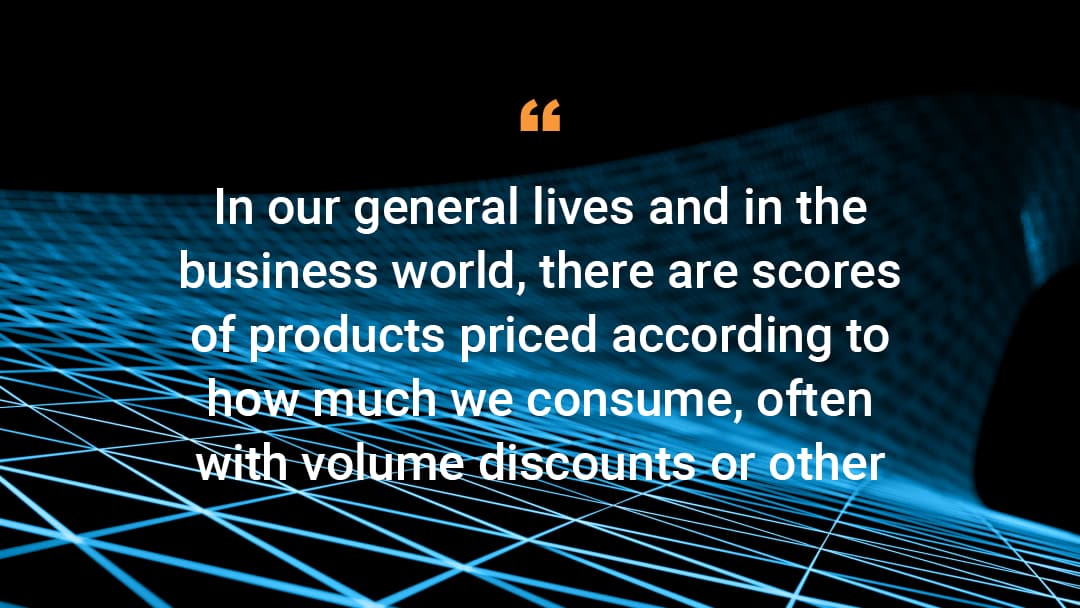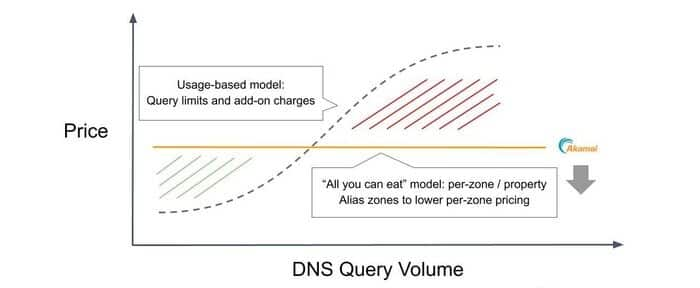Distinguishing Among DNS Services Part 2: The Economics

This is Part 2 of a 3-part blog series highlighting some of the distinguishing aspects of Akamai's DNS services, Edge DNS and Global Traffic Management. Part 1 focused on Akamai's DNS platform and what sets it apart. In Part 2, we take a closer look at the economics of DNS pricing models and why Akamai's approach is unique.
In our general lives and in the business world, there are scores of products priced according to how much we consume, often with volume discounts or other incentives tacked on that reward more consumption. In building a list of those products, DNS services may not come to mind first, but they certainly claim a spot.

Many DNS providers price their services according to consumption, offering "small/medium/large" pricing tiers, and rewarding more consumption (i.e., more queries) with volume discounts (lower price per query). To strengthen the appeal of their services to prospective customers, some DNS providers publish entry-level pricing on their websites or offer services as part of a bundle, a tactic that projects transparency and simplicity, but can also be misleading. The approach works well for those providers (or they wouldn't use it), but doesn't always work out well for customers who watch their bills increase as consumption grows. Consumption-based pricing for DNS also introduces an element of unwelcomed unpredictability into the monthly billing cycle, especially when usage spikes upward for any reason.
Indeed, as internet traffic volumes grew during the 2020 coronavirus pandemic, at least one customer shared with us that it was receiving larger-than-normal DNS bills from its provider. We've also heard of situations in which customer bills spiked as a result of volumetric DDoS attacks, although in fairness, reputable providers offer abatements in such cases so that customers aren't penalized financially for being victimized. But not all providers do this, so it bears mentioning.
Akamai takes a different approach. First, we don't offer pricing tiers that place limits on query volume, and we don't dictate the hours you can call customer support, which are both terms and conditions we've seen published on the websites of some providers. Instead, we consult individually with each customer to understand the nature of their business, where their end users are located, their data center and cloud profile, their websites and applications, their overall security posture and requirements, and other factors that impact their DNS needs.
Moreover, of the major DNS providers we track, Akamai is the only one that doesn't factor consumption, i.e., number of queries per month, into its pricing. Our pricing is "flat," that is, based only on the number of configured DNS zones (Edge DNS), or the number of configured load-balancing properties (GTM) managed by the customer as part of the service. It's an approach that takes into account the customer's digital footprint and architectural needs, but not the volume of traffic generated to the customer's web properties. For customers that value predictability in their monthly bills, or prefer to budget without concern for overage charges caused by unanticipated increases in query volume, this flat pricing model can be appealing. Our customers are also able to save money by using zone aliases or other methods to reduce the number of zones or properties they manage. In fact, our customer and product teams often work directly with customers on ways to optimize their configurations as a way to increase efficiency and reduce their bills.
This is not to say that our DNS services are less expensive in all cases. Consider the simple graph below. The dotted line shows a typical pricing trajectory for consumption-based DNS providers -- low pricing at low query volumes that accelerates upward as query volume increases. The solid line represents Akamai's "flat" pricing. While our pricing is usually higher at low query volumes, as the number of queries increases, monthly bills from Akamai stay flat, ultimately becoming lower than consumption-based plans as query volumes increase.

What this shows is that larger organizations that drive higher traffic volumes to their web properties (as measured by metrics such as page visits and duration time) tend to benefit cost-wise from flat pricing. It also shows that small and some mid-market organizations whose websites don't generate a lot of queries will often pay less with a usage-based model. Over time, however, as their businesses grow and their websites generate more visits, they may suddenly find themselves paying more.
Still, value in DNS services extends beyond cost savings. Customers can also benefit from the unique qualities found in their provider's DNS network, which was the subject of Part 1 of this blog series. If you didn't read that post, or don't have the time or inclination to read the paper that was highlighted, here's a brief synopsis: Akamai's DNS was originally designed and built to support the underlying mapping algorithms for our CDN. Because of its critical importance to our business, our engineers were maniacal about building a global DNS infrastructure with the programmability, scalability, resilience, and performance needed to support our core business. They were so successful in this regard that our CDN customers eventually began to inquire about using our DNS network in place of their own premise-based DNS solutions. That was the advent of what eventually became Edge DNS and GTM. For organizations, even smaller ones, that consider their online businesses to be critical, the value of a DNS network such as Akamai's is worthy of consideration, especially if the network that supports a less costly service is less reliable or less resilient.
The value of a DNS service extends further, to the role DNS can play as part of an organization's overall security posture. To that, Akamai's DNS platform was built with the scale and capabilities needed to function normally, even while subjected to extremely large DDoS and other attacks. These capabilities, too, are covered in the paper referenced above.
Finally, there is value in partnering with a DNS provider that continuously invests and reinvests in product improvements and enhancements that add efficiency, boost performance, and protect digital footprints. Akamai recently coauthored an important new IETF standard, and extended our DevOps capabilities, to name just two of the enhancements highlighted in our October 2020 Platform Update.
Indeed, Akamai's flat pricing model for authoritative DNS is differentiated, offering both cost savings, whether near-term for high volume customers or as smaller customers experience traffic growth, and predictability, especially when traffic levels spike or become volatile. But beyond price, we hope customers will choose our DNS services based on the additional value they expect to receive, whether from the reliability of those services, our 100% uptime SLA, the overall quality of our network, the strength of the other products in our portfolio, or their trust in Akamai, both as a partner, and as a company with a lengthy and accomplished track record in DNS. Those attributes also set us apart, and ideally, customers and prospects will consider all of these on their way to choosing their DNS provider, whether for secondary or primary.
To learn more about Akamai's authoritative DNS products, you can visit their respective product pages:
If you're interested in a free trial of either product, here's where you can sign up:






